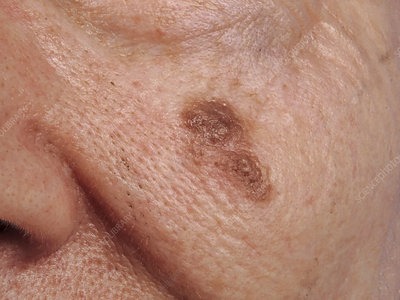Lentigo Maligna (LM)
 Lentigo maligna is generally a precursor to lentigo maligna melanoma, which is a form of serious skin cancer. Lentigo maligna is also called Hutchinson melanotic freckle. This is a form of early melanoma in which malignant cells remain confined to the epidermis (tissue of origin). The condition is also called ‘in situ’ melanoma.
Lentigo maligna is generally a precursor to lentigo maligna melanoma, which is a form of serious skin cancer. Lentigo maligna is also called Hutchinson melanotic freckle. This is a form of early melanoma in which malignant cells remain confined to the epidermis (tissue of origin). The condition is also called ‘in situ’ melanoma.
The condition occurs in sun damaged skin and is usually found on the neck and face, particularly the cheek and nose. The melanoma grows gradually in diameter over a period of 5 to 20 years.
Lentigo maligna melanoma is said to occur when the melanoma cells invade into the dermis and other deeper skin layers. Lentigo maligna has a lower transformation rate to invasive melanoma as opposed to other melanoma in situ forms. The risk of invasive melanoma is usually greater in larger lesions.
Texas Surgical Dermatology, led by board certified dermatologist Dr. Tri H. Nguyen, provides treatments for lentigo maligna (LM) skin cancer to patients in Houston, Katy, Spring, The Woodlands, Texas, and surrounding locations.
Lentigo Maligna Dermoscopy
Dermatoscopy or dermoscopy is helpful in differentiating lentingo maligna from other skin lesion types. It involves the use of a dermatoscope by a trained doctor or a dermatologist.
Diagnostic Excision Biopsy
Excision biopsy is performed for cutting out the skin lesion that is clinically suspicious of lentigo maligna. This is done with a 2 to 3 mm margin. Complete excision biopsy is more accurate than partial biopsy. A single small biopsy can miss a malignant skin lesion.
In some cases, lesions are very large and a partial biopsy is performed for confirming the diagnosis before carrying out a significant surgery. The doctor will remove a long skin ellipse, shave a representative area for histology or take biopsies from multiple areas.
Complete Surgical Excision
The best treatment for LM is complete surgical excision with histological margins. This allows for histopathological assessment of the margins for ensuring the tumor is completely removed. It also allows for the detection of clinically inapparent invasive components. The procedure removes hair follicles in which atypical melanocytes may exist, which decreases the risk of recurrence.
Higher clearance rate is achieved by surgical excision as compared to non-surgical treatments. This is why the procedure is considered to be the first-line treatment for LM. Definite surgical excision should occur within 4 – 6 weeks following the LM diagnosis.
The aim of the procedure is to completely excise the lesion with tumor free margins while conserving maximum healthy tissue. This helps in maximizing the patient’s life and entails the least possible functional and aesthetic prejudice.
Surgical Excision Techniques
Surgical excision can be performed through various modalities, such as wide (standard) excision with complete peripheral margin assessment and predefined safety margins. The techniques include the square method, radial section, the ‘spaghetti’ technique, the perimeter technique, and Mohs micrographic surgery (MMS).
Microscopically-controlled SSE, in comparison with wide excision, achieves lower recurrence rates. However, a recent study did not find patients treated for LM of the limbs and trunk to have different survival rates with MMS.
Board certified dermatologist Dr. Tri H. Nguyen at Texas Surgical Dermatology receives patients from Houston, Katy, Spring, The Woodlands, Texas, and nearby areas for lentigo maligna (LM) skin cancer treatment.
For More Information contact our Board Certified in Dermatologists at Texas Surgical Dermatology in Spring, TX
For more information on procedures and treatments offered at Texas Surgical Dermatology PA please call 832.663.6566 or click here to contact our dermatologists. Helping patients in Houston, The Woodlands, Spring, Katy and other surrounding areas of Texas.

